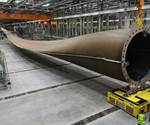SAERTEX provides material for 87.5-meter carbon fiber spar cap
The wind blade spar cap prototype, said to be the longest carbon fiber spar cap so far produced via vacuum infusion.
SAERTEX (Saerbeck, Germany) announces its contribution to the production of a prototype carbon fiber spar cap made using vacuum infusion technology.
The 87.5-meter, 800-millimeter diameter spar cap, said by SAERTEX to be the longest ever produced, was completed in April by a wind turbine blade manufacturer in China. The spar cap, designed by WINDnovation Engineering Solutions (Berlin, Germany), is made of carbon fiber to reduce the part’s weight and achieve higher stiffness, which is essential for rotor blades of such extreme length.
The carbon fiber used for the part was SAERTEXs infusion-optimized unidirectional, 618-gsm non-crimp carbon fiber fabric, which features increased z-permeability and was specially developed for the infusion of thick lay-ups. The resin system used was CTP AM’s (Duisburg, Germany) 3325 A/B epoxy resin with optimized viscosity and extended pot-life.
The spar cap was infused in VAP technology with Composyst’s (Hurlach, Germany) VAP membrane CS/E which enables degassing of the resin during the entire infusion and eases resin distribution throughout the entire part, as well as control of the resin content in the part. The infusion process is said to have taken less than two hours.
Related Content
-
Materials & Processes: Fabrication methods
There are numerous methods for fabricating composite components. Selection of a method for a particular part, therefore, will depend on the materials, the part design and end-use or application. Here's a guide to selection.
-
Recycling end-of-life composite parts: New methods, markets
From infrastructure solutions to consumer products, Polish recycler Anmet and Netherlands-based researchers are developing new methods for repurposing wind turbine blades and other composite parts.
-
Materials & Processes: Fibers for composites
The structural properties of composite materials are derived primarily from the fiber reinforcement. Fiber types, their manufacture, their uses and the end-market applications in which they find most use are described.

.jpg;width=70;height=70;mode=crop)














